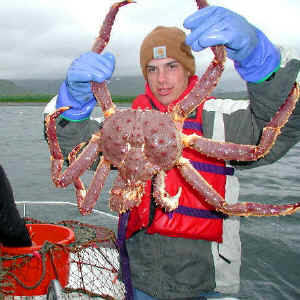Classification
The red king crab, Paralithodes camtschatica, has a reddish-brown body and characterized by its fan shaped tail. To cover the basics, they are bilaterally symmetrical, ectothermic, as well as heterothermic. For sexual dimorphism, their sexes look very alike, mainly differing in their size, males are usually bigger, and through the different shapes of their abdominal flap. The average lifespan for the king crab is usually from 15-20 years, yet the longest known wild lifespan can be from 20-30 years.1
 “If bigger is better, then the king crab is the best crab you can buy,” says the
Pacific Sea Group. But this statement is true. The red king crab is the
largest member in its family, the spider crabs, weighing as much as 20 pounds,
usually averaging six to eight lbs.2
Also, this remarkably large species can
have a carapace up to 11 inches in width and leg span exceeding six feet!3
“If bigger is better, then the king crab is the best crab you can buy,” says the
Pacific Sea Group. But this statement is true. The red king crab is the
largest member in its family, the spider crabs, weighing as much as 20 pounds,
usually averaging six to eight lbs.2
Also, this remarkably large species can
have a carapace up to 11 inches in width and leg span exceeding six feet!3
The head and thorax of a crab are fused together. Even though fused, the crab is still segmented, having 5 sets of legs, the first pair being their claws, or pincers, the next three pairs being walking legs, and the last pair being fairly small, which are tucked up underneath the carapace.4 The king crab’s number of legs and claws set them apart from other crab species in that most crabs have 4 sets of walking legs, king crabs having 3, and that the king crabs differ in their types of claws. They have a larger right “killer” claw for crushing and a smaller “feeder” claw on the left for manipulating their food.5 On the head of the crab, there is a collection of antennae and mouth parts, including the mandibles, maxillae, and maxillipeds. The king crab’s carapace is heavily calcified and is covered with many sharp spines, their legs also covered in spines, for increased protection.6 P. camtschatica uses tactile and chemical communication, using both sense of touch and pheromones to interact with each other and their environment.
 Distinguishing characteristics of the red king
crab are more than just size and color. The red king crab and the blue king
crab, its nearest relative, are not so easy to tell apart, making their size and
shell color not decisive enough. The red king crab differs in its skin coating,
being a pink color, while the blue king crab is a deeper red. Also their spine
colors differ, the red king crab’s being red and white tipped and the blue king
crab being blue and black tipped.7
The number of spines is also a definite distinguishing trait, red
king crabs having 33 spines total on its carapace, 9 in front, 9 on each side,
and 6 in the back.8
This picture by Lis Lindal Jørgensen
of the red king crab, showing the different areas of its carapace.
Distinguishing characteristics of the red king
crab are more than just size and color. The red king crab and the blue king
crab, its nearest relative, are not so easy to tell apart, making their size and
shell color not decisive enough. The red king crab differs in its skin coating,
being a pink color, while the blue king crab is a deeper red. Also their spine
colors differ, the red king crab’s being red and white tipped and the blue king
crab being blue and black tipped.7
The number of spines is also a definite distinguishing trait, red
king crabs having 33 spines total on its carapace, 9 in front, 9 on each side,
and 6 in the back.8
This picture by Lis Lindal Jørgensen
of the red king crab, showing the different areas of its carapace.
|
Kingdom |
Animalia |
They are living, breathing eukaryotic organisms, lacking a cell wall. (Freeman, 2005) |
|
Phylum |
Arthropoda |
They are classified as protostomes in the subgroup Ecdysozao, having segmentation, also having a jointed exoskeleton like its ancestors, the insects, scorpions, and millipedes. (Freeman, 2005) |
|
Class |
Malacostraca |
They have a shell, a carapace, as well as a short tail. (“Red King Crab: Information from Answers.com” Answers.com) |
|
Order |
Decapoda |
They have 5 pairs of walking legs as well as a cephalothorax. (“Red King Crab: Information from Answers.com” Answers.com) |
|
Family |
Lithodidae |
They have a reduced fifth walking leg and are king crabs found in the cold seas. (“Red King Crab: Information from Answers.com” Answers.com) |
|
Genus |
Paralithodes |
They are edible, deep sea crabs found along the coasts of Japan to Canada.(“Red King Crab: Information from Answers.com” Answers.com) |
|
Species |
Paralithodes camtschatica |
Are the largest king crab which is a reddish/brown color, having 33 red and white spines and a extensive carapace.(Jørgensen, 2006) |
(Ghiselin, 2007)
Phylogenetic Tree Below!






![]()
![]()
![]()
![]()
![]()
![]()
![]()
![]()
![]()
![]()
![]()
![]()
![]()
![]()
![]()
![]()
![]()
![]()